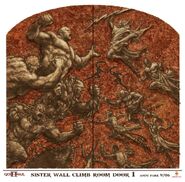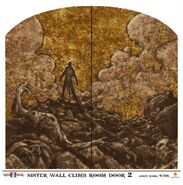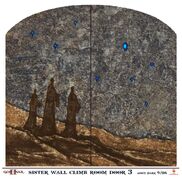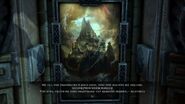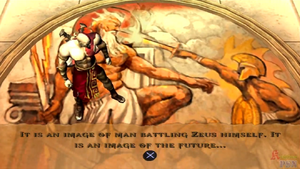
Prediction of Kratos' retaliation and the Second Titanomachy
Throughout the God of War series, there have been many incidences that some claim to be either revelations or predictions. Many of these give a heads-up of what is to happen in later games or events. Some of these instances are even biblical.
God of War[]
The above image seen in Pandora's Temple in God of War shows a battle between Zeus and a lone warrior. In God of War II, that lone warrior turns out to be Kratos. How Pathos Verdes III knew of the Second Titanomachy is unknown, like many other aspects of passages and statues within Pandora's Temple. Interestingly enough, Zeus isn't portrayed with a long white beard in the first game when he appears to Kratos to give him Zeus' Fury. This image is also seen in God of War II, throughout the Island of Creation.
In Kratos' flashbacks, when he has Lysandra in his arms after killing her, Ares appears and tells Kratos that he had all along planned the scheme that made Kratos murder his wife and child, in order to take away the "obstacles" that could prevent Kratos' transformation into the perfect warrior, and becoming "Death itself". Years later, as a god, Kratos killed Thanatos, the God of Death, and, in the Grave Digger's own words, became "Death, the destroyer of worlds". One can conclude that, even unintentionally, Ares predicted that Kratos would somehow overcome Death.
God of War II[]
The murals within the Inner Sanctum of the Temple of the Fates had depictions of the events that occurred in the First and Second Great War.
First Mural[]
In the first mural, "The all consuming battle between the Titans and the Olympians rages on", the Olympians and the Titans engaging in a brutal battle is shown. Possibly the first Titanomachy or the Second that took place in God of War III.
Second Mural[]
In the second mural, "A lone soul surveys the wake of carnage that surrounds him". It could possibly mean that a lone man, possibly Kratos, stood amidst the destruction left behind after the Second Great War.
Third Mural[]
In the third mural, it depicts "Three travelers heading to an unknown destiny". The mural shows three men walking towards a star in the sky, alluding the journey of the Three Wise Men towards the birth of Jesus Christ guided by the Star of Bethlehem. This also signifies that after the end of the Greek Gods, Christianity has surfaced alongside other religions of the world. Another curious aspect is that in God of War II, a Griffin Rider wields a weapon called the Spear of Destiny, which shares its name with the spear used by a Roman soldier, Longinus, to impale Christ's side after his crucifixion.
God of War III[]
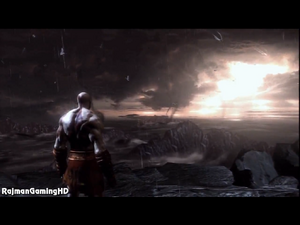
Kratos and the primordial world (Chaos)
Only the first two prophecies of the murals have been fulfilled in God of War III: The war between Gods and Titans and Kratos, the last survivor of the war, who attempted to commit suicide with the Blade of Olympus at the end to give hope to mankind. However, an after credit scene shows a pool of blood where Kratos had fallen and a trail of that blood led to a cliff, where no body is seen. He survived and returns in God of War (2018).
Interestingly, there is an image where Kratos laid after impaling himself. It closely resembles a Phoenix, which is reborn from its ashes after death. This could be interpreted as Kratos starting a new life after the destruction of all he knows. However, the image could also be an eagle as that is Zeus' symbol.
It is possible the other murals have been fulfilled. As Kratos kills off the Gods of Olympus as well as releasing the evils of Pandora's Box, and finally giving hope to all of mankind, he can be seen as the catalyst to the age of man and Christianity. This could be seen as the prologue to the age of man. As the Gods died, the ocean and sea levels rose, the dead souls wandered the earth aimlessly, the sky blackened as clouds blocked the sun, locust and bacteria carrying flies swarmed all over, and disease spread across the remaining population (among other things), all could be references to the Plagues of Egypt as referred in the Book of Exodus.
It is also worth noting that the book of Genesis describes beings known as "Nephilim", superhuman entities who were the sons of angels and humans and are called the "heroes of old, the men of renown." The book shortly thereafter describes a cataclysmic flood which destroys most of the life, including the Nephilim, on Earth, obliterates all civilizations, and ushers in the age of Judaism as a handful of survivors rebuild the world from scratch; much like the flood brought forth by Kratos' actions in God of War III destroy the Gods, mythical beasts, and all of the perceived world by the end of the game. If the murals in the Hall of the Fates are any indication to the Judeo-Christian nuances in the series, perhaps the Gods of Olympus and supporting mythological figures found throughout the games are to be the Nephilim, the legendary heroes and men of old. Where Kratos and his new-found redemption fit in this theory, it is hard to say; though given that Kratos caused the flood and the other plagues, it could be implied that he may become something akin to the Christian God, leaving Deimos and having escaped from the Underworld. Yet as of Deimos' death in God of War: Ghost of Sparta, this idea is unlikely to happen.
Of interesting note is that God of War III was released on March 16. 3:16 is a famous verse from the Bible. John 3:16 - "For God so loved the world that he gave his one and only Son, that whoever believes in him shall not perish but have eternal life". Whether this was intentional on the part of the developers is unknown, as it could be referring to the game's scene with Kratos overlooking the world of chaos.
An Omega is seen behind the series' title, Omega is the last letter in the Greek alphabet and could possibly be a prediction of the end of God of War III where Kratos, the former God of War, killed the Olympians and thus ended their rule. So the fact that there is an Omega sign may possibly symbolize the end of the Olympians. In the cover for God of War II it also said "The End Begins."
God of War: Ascension[]
In God of War: Ascension, two visions of Aletheia are revealed; the first depicts Olympus after the Second Titanomachy. Spirits are then seen fleeing from the depths of the Underworld while thunder roars, as Olympus burns. The prophetic image also contains a code: QUJIKPHIUEEKMJQUJ. Once cracked, the code will reveal a new premonition, WHEN THE EARTH STOPS, THE JOURNEY BEGINS...". This painting was a hint to a subsequently abandoned new IP Sony Santa Monica were developing, independantly from the God of War series.
God of War (2018)[]
see: Ragnarök
Gróa was the first person to ever foresee the coming of Ragnarök: a three-year winter (the Fimbulwinter) where the Realms quaked and the skies split, a horrible terror emerging with a flaming sword, an enormous wolf (Fenrir), Gods fighting against each other (The Aesir-Vanir war), and a white ghost from another land with his son.
In Jötunheim, the room is adorned with statues and carvings of Giants, written prophecies in its walls and a mural depicting the story of "Loki" and the last mural depicts the death of a figure that resembles the Ghost of Sparta himself (later revealed to be Odin).
God of War: Ragnarök[]
Atreus with the help of Sindri discovered in a temple in the wild woods that Jötnar Shrines contain secret knowledge. According to the true prophecy of Ragnarök, which o Skoll and Hati, the God of War who was to be Týr as interpreted by Atreus would lead an army that consists of the other realms of Yggdrasil against Asgard. Eventually the God of War would improved the army against the Asgardian forces. However, what Atreus didn't know was that Týr was not the God of War in the prophecy but his own father Kratos.
Gróa, who had foreseen this, and to keep it a secret, proceeded to lie to Odin saying that Ragnarök will be the end of all things when, according to the Shrine in Alfheim it is only the end of Asgard.
According to the secret knowledge in the shrine of Surtr in Muspelheim, Surtr himself will merge with his love Sinmara and they will become a great destroyer of worlds called Ragnarök who will destroy Asgard, while the original triptych on the shrine claimed that it is only Surtr who will destroy Asgard and not the being he will become.
When Kratos and Atreus find the last Jötnar shrine, which is on both of them, Angrboda had made a new prophecy that Kratos will become a beloved god as his prophecy was overwritten when the Spartan, during Ragnarök told his son to continue opening his heart to others and that he would the same.
Trivia[]
- In God of War: Directors Live, David Jaffe and Cory Barlog mentioned their ending to God of War III. Interesting to note is that they also brought up the ending of the Three Wise Men. This storyline could have been dropped (or adapted, making the Three Wise Men become the Three Judges in God of War III), David Jaffe having left Sony only 3 months after God of War II's release.
- In the original draft by David Jaffe, the Three Wise Men were meant to be Kratos and his Norse and Egyptian counterparts, after they wiped out the Olympians, the Gods of Asgard and the Egyptian Pantheon.
- It was later revealed (or at least implied) by Santa Monica's animation director Bruno Velazquez on Twitter that the painting of the three men on God of War II was indeed meant to directly reference Christianity, and that the Christian God exists on the universe of the series.
- It was similarly revealed by Bruno Velazquez that the prophecy on God of War: Ascension depicting the Earth and a new journey was merely an easter egg to another (now cancelled: God of War: Redemption) game Santa Monica was producing at the time, and that it had no bearing on God of War.

